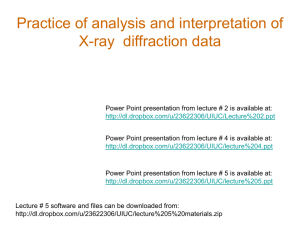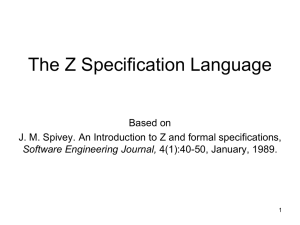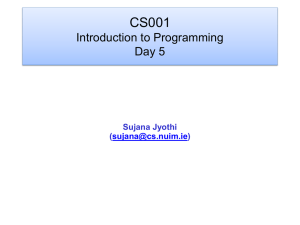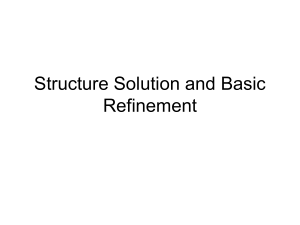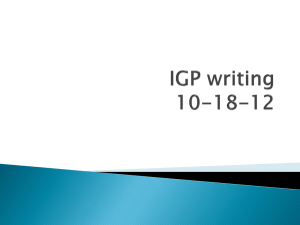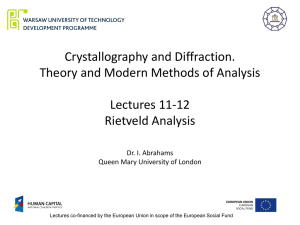Refinement of a Single Phase - Prism Web Site
advertisement
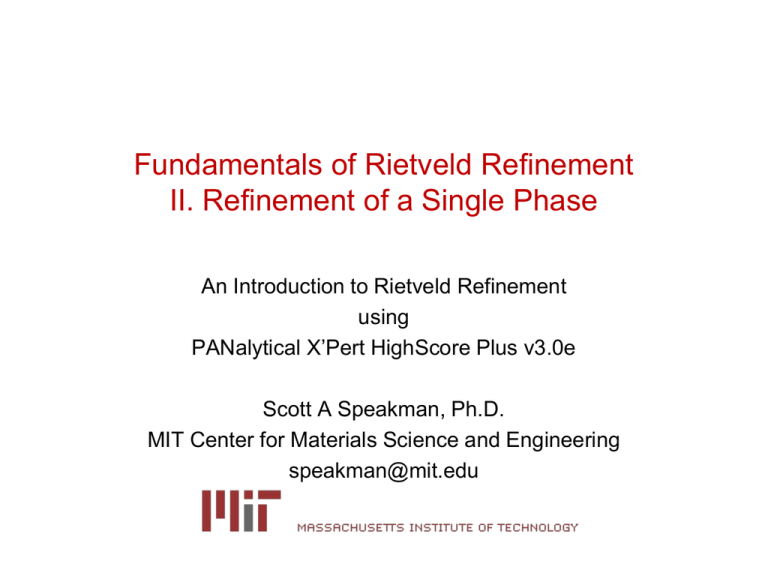
Fundamentals of Rietveld Refinement II. Refinement of a Single Phase An Introduction to Rietveld Refinement using PANalytical X’Pert HighScore Plus v3.0e Scott A Speakman, Ph.D. MIT Center for Materials Science and Engineering speakman@mit.edu The Rietveld Method 1. 2. 3. 4. The parameters previously discussed are used to create a model A diffraction pattern is calculated from the model The calculated pattern is compared to the observed data The differences between the observed and calculated patterns are minimized by varying parameters in the model through a least squares process 5. When the calculated and experimental diffraction patterns match, the model may represent the original sample • The Rietveld Method requires: – high quality experimental diffraction pattern – structure model that makes physical and chemical sense – suitable peak and background functions 2 There are several places to configure HSP settings before beginning a refinement • Select a preconfigured or custom desktop – go to View > Desktop to select a desktop – the “Structures” desktop is well suited for Rietveld refinement – a quirk of HSP: imagine that the “Structures” desktop was selected but was then changed. In order to reset to the desktop to the “Structures” layout, you need to select another desktop and then select the “Structures” desktop again • In Customize > Defaults you can set the starting values for several XRD pattern simulation parameters – Default Instrument Settings • Change these if you are routinely analyzing data that were not collected with a PANalytical diffractometer – Default Global Settings • Set the Background Method to the type you most often use (polynomial, use available background) • Set the Profile Base Width (in Refinement) to 8 or more Program Settings contains several options important for Rietveld Refinement • Go the menu Customize > Program Settings – Click on the button Reset All to Default to change parameters to the default behavior. – After doing this, you might want to change a couple of settings to be better optimized for Rietveld analysis • In the General tab – Set Auto-save time and Number of Undo/Redo steps as you like – Adding more undo steps will slow down the program • In the Rietveld tab – check “Show selected Phase Profile” – check “Calculate Correlation Matrix” – Check “Keep R-value Graphics Open after Refinement” – Check “Undo Refinement Control Editing” Do not process the data before Rietveld refinement • Do not subtract the background before refinement – The background will be modeled during the Rietveld analysis • Do not strip K alpha-2 peaks before refinement – The K alpha-1 and K alpha-2 peak doublet will be modeled by the profile function • Do not smooth the data before refinement – Rietveld refinement relies on a statistically comparison to your raw data which will be invalid if your data are smoothed • The only processing you should consider is converting ADS data to FDS – Use this option only if you collected data from an infinitely thick sample using Automatic mode with the Programmable Divergence Slits Slide ‹#› of 20 You must define the instrument parameters and correct your data if variable slits were used • The Divergence Slit Type is reported in the Object Inspector for the Scan – In the Lists Pane, select the Scan List tab. This will load scan information into the Object Inspector – In the Object Inspector, scroll down to the Instrument Settings area – If your data were collected with a PANalytical instrument, these values are already defined – If your data were not collected with a PANalytical instrument, you should input the correct Divergence Slit Type, Anode Material, and Goniometer Radius • The Divergence Slit Type is: – Fixed for a fixed divergence slit aperture – Automatic for a variable divergence slit aperature • If your data were collected using variable divergence slits, you must correct for the constant volume assumption – Variable slits are the Programmable Divergence Slit (PDS) in “Automatic Mode” on the PANalytical X’Pert Pro You must correct your data if they were collected using variable divergence slits • If your sample was ‘infinitely’ thick, then the irradiated volume was increasing. This can be corrected in HighScore Plus. – – – – – • If your sample was thin, then the irradiated volume was constant. In this case, you must change the instrument setting for your data in HighScore Plus. – – – • Select the menu Treatment > Corrections > Convert Divergence Slit Load the default parameters Click the ADS to FDS button Click the Replace button Click the Close button In the Lists Pane, select the Scan List tab. This will load scan information into the Object Inspector In the Object Inspector, scroll down to the Instrument Settings area. In the entry for Divergene Slit Type, change it from Automatic to Fixed. • This will tell HighScore Plus that your data fulfilled the constant volume assumption, even though variable slits were used. If your sample was thin and you used fixed divergence slits, then the data cannot be analyzed by Rietveld refinement because they do not fulfill the constant volume assumption. To load in a crystal structure model for refinement • • You can manually enter the crystal structure as detailed in Part I of this tutorial You can download a *.cif file from an online database (such as http://www.crystallography.net/) or journal. – Then, go to File > Insert to load the *.cif structural information in to your data. • You can search the database linked to HighScore Plus (such as PDF4, ICSD, or COD) for your reference card – In the Quality tab of the Restrictions dialogue, be sure the check “Skip patterns without structure data”. – This will guarantee that all reference patterns you retrieve contain crystal structure information The reference card must be converted before you can use it as the starting basis for unit cell refinement • After you have loaded the reference card(s), go to the Pattern List tab in the Lists Pane • Right-click on the phase(s) that you want to refine • Select “Convert Pattern to Phase” from the menu • The reference(s) that you converted are now listed in the Refinement Control tab of the Lists Pane For this tutorial • Open the dataset “LaB6 toploaded.xrdml” – This is a top loaded sample of LaB6 collected on a PANalytical X’Pert Pro using Programmable Divergence Slits in the Fixed mode – Since the sample was collected on a PANalytical instrument, instrument parameters are automatically input into the program • Find a reference pattern for LaB6 that contains crystal structure information • Convert the pattern to a phase to prepare it for analysis Starting a Refinement • Calculate the diffraction pattern – click the “Start Pattern Simulation” button in the Rietveld toolbar, or – Select Analysis > Rietveld > Start Pattern Simulation • • • the total intensity will not match because the scale factor is wrong make sure that peak positions match up approximately The range and step size for the simulation will be automatically set to match the experimental data The Semi-Automatic Refinement Mode gives you control over which parameters are refined • Set the Refinement to Semi-automatic Mode – Use the drop-down menu in the Rietveld toolbar – Use the drop-down menu in the menu Analysis > Rietveld > Refinement Mode • How to flag parameters for refinement – In the Lists Pane, select the Refinement Control tab – To mark a parameter for refinement, put a check mark next to the parameter in the ‘Refine’ column – Then click on the “Start Rietveld Refinement” button Define how the background will be fit • You must decide how you are going to fit the background – – • You could manually fit the background and use that during the refinement You could fit the background using a polynomial or other equation and allowing the background parameters to refine during the Rietveld refinement To change the background method – – In the Refinement Control Lists Pane, select Global Variables In the Object Inspector, select an option from the drop-down menu for the Background Method • This menu is near the top of the list in the Object Inspector When you begin a refinement, you do not want to refine too many parameters at the same time • • When we begin the refinement, we refine only a few parameters simultaneously If you refine too many parameters at the same time, the refinement will diverge – • i.e. blow up, go crazy, fail Remember, the computer is guided by numbers, not by common sense – – The computer only cares about minimizing the least-square residual for example, the computer could begin shifting the peak positions, intensities and widths in order to fit the background if we refine those parameters before getting a good background fit The computer thinks this is the beginning of a good refinement The Steps for Rietveld Refinement 1. First, refine only the Scale Factor – Put a check mark next to Scale factor – Click on the Start Refinement button • The calculated peak intensities should now match the experimental data – The calculated peak intensities may be different if there is substantial peak shift, so that the calculated peak positions do not match the observed peak positions Refine the background, adding one additional term at a time 2. Scale Factor + Flat Background – sometimes it helps to change the y-axis to square root scale to better evaluate the background fit 3. Scale Factor + Flat Background + Coefficient 1 4. Scale Factor + Flat Background + Coefficient 1 + Coefficient 2 5. Scale Factor + Flat Background + Coefficient 1 + Coefficient 2 + 1/X Background – The increase in background at low angles of 2theta can be well modeled using the 1/X Background term How to tell if the refinement is proceeding well • First, look at the data – If the peak positions fit fairly well at this point, continue improving the background fit – If the peak positions don’t fit well at this point, refine peak positions starting with specimen displacement – based on the result that we see, the calculated peak position is slightly too high • set Additional Graphics to show ‘Difference Plot’ – go to View > Additional Graphics > Difference Plot – This plot will show the difference between the observed and calculated diffraction patterns Also Use Agreement Indices to Evaluating the Refinement • The Agreement Indices quantify how well the calculated XRD pattern fits the experimental data – – • Rexpected shows the best possible value for the Residual – • A lower Rexpected value indicates higher quality data R profile and Weighted R profile show how well the calculated pattern matches the experimental data – – • Click on “Global Parameters” in the Refinement Control list The Agreement Indices are shown in the Object Inspector we want the Weighted R profile to be less then 10% and as close to the R expected value as possible R expected is an estimation of the best possible R profile based on the statistical noise of the experimental diffraction pattern GOF (goodness of fit) is wRp/Rexp. – – This should approach 1 GOF is more and more irrelevant because modern detectors mess up the statistical validity We need to refine the peak position 5. Previous parameters + Specimen Displacement – The lattice parameter of LaB6 is well known, so peak shift is most likely due to either specimen displacement or zero shift error • displacement- peak shift varies as cos q 2q 2s cos q in radians R • zero shift- peak shift constant vs q • never never never refine both at the same time!!! • Usually you should refine lattice parameter next, but we can see that the peak width is the more significant error With peak positions and background fit well, begin refining peak profiles • keeping all previous parameters checked, start refining profile parameters – we keep refining the peak position parameters because as the peak width and shape changes the peak position may change in response – initially, we only refine 1 profile parameter at a time • if we try refining too many too soon, the refinement will diverge 6. start refining Cagliotti parameters one at a time a. b. c. 7. 8. W only V only U only LaB6 toploaded LaB6 100.0 % refine Peak Shape 1 (not refining any Cagliotti parameters) look at the lowest angle peaks to determine if you need to refine the peak profile asymmetry – – in this case, we do need to refine the asymmetry parameter Repeat steps 6-8, refining parameters one at a time, a few times 21 21.20 21.40 21.60 Position [°2Theta] (Copper (Cu)) 21.80 • look at high angle peaks (88°)- note how Ka1 and Ka2 are both modeled • • If the Ka2 ratio is off, you may need to change the polarization correction To find POL values, look in help (search keyword polarization) • • these data were collected using a Ni beta filter, so POL=1 values are entered by: • • • • LaB6 toploaded LaB6 100.0 % click on Global Parameters (in Refinement Control list) in Object Inspector, find Polarization Correction Coefficient under General Properties in this case, it is correctly set to 1 87.60 87.80 88 88.20 Position [°2Theta] (Copper (Cu)) look at a low angle peak (30.5°) – – – note how the peak profile is truncated not much of a problem for this data set, but for others it might greatly compromise the refinement change values: • • • • LaB6 toploaded LaB6 100.0 % click on Global Parameters (in Refinement Control list) in Object Inspector, find Profile Base Width under Refinement change to 8, rerun refinement can change “permanently” in Customize > Defaults ... 30.20 30.40 30.60 Position [°2Theta] (Copper (Cu)) The peak positions are slightly off, so we need to refine lattice parameters • Look at the high angle peaks- the positions are slightly off • Even though the LaB6 lattice parameters are well known, we need to refine the lattice parameters anyway • Refine the lattice parameter a – b and c will refine automatically In addition to Agreement Indices, we can look at estimated standard deviation to evaluate the precision of refined parameters – look at columns: value, deviation, maximum, minimum, Use Min/Max, Constraint, Last Shift • I usually rearrange the columns in the order shown below (just drag and drop the column headings) • the small deviation value for the lattice parameter indicates that the refinement is fairly stable and that we are approaching a good solution • In the Refinement field of the Global Parameters Object, seen in the Object Inspector pane, we can also view and change – Several limits are used to speed up the refinement calculation • Profile base width: limits the 2theta range over which the intensity contribution of a peak (hkl) is calculated – – • • – – – assumes that the intensity contribution from a peak is zero beyond this range the base width values constrains the range in multiples of the FWHM maximum angle of asymmetry correction: peaks below this angle are corrected for asymmetry. peaks above this angle are assumed to be symmetrical intensity limit: Refinement does not calculate or refine using peaks with a calculated intensity less than the intensity limit the profile function used to calculate the shape of all diffraction peaks the Weighting scheme puts greater emphasis on Iobs or Icalc in the refinement residual max. no. of least-square cycles • • • maximum number of times the parameters are refined before the refinement stops (assuming other criteria do not cause refinement to stop) if this number is set too low, the refinement may cease before the parameters are truly optimized if this number is set too high, the refinement may take much longer than necessary or may be unstable before we continue improving the profile fit, lets remind ourselves what is currently being refined • right-click on any value in the Refinement Control list • choose “Show Refined Values/Constraints ... “ • the table shows us what parameters are currently checked to be refined To finish the refinement, we need to begin refining multiple profile parameters at the same time – Peak width and profile parameters are going to affect each other – for a complex refinement, we would go through several iterations of refining one parameter at a time – refine W only, then V only, then U only, then Shape 1 only, then W only, then V only, then U only, then Shape 1 only, then asymmetry only, then W only, then V only, then U only, then Shape 1 only, then asymmetry only ... – then begin refining some parameters together at the same time – Because this is a high quality experimental pattern of a simple and well crystallized sample, we can begin refining multiple profile parameters at the same time 1. W 2. W+V 3. W+V+U 1. notice large change in these parameters as they influence each other 4. W+V+U + Peak Shape 1 5. W+V+U + Peak Shape 1 + Asymmetry Evaluate the quality of the refinement • Let us consider the current refinement – Weighted R profile > 10 and GOF > 4, which usually aren’t very good – visually, it is approaching the “not bad” level of quality • Consult the values for deviation – all values are fairly small, showing that the refinement is stable – a large deviation means that that parameter could vary by a large amount without affecting the quality of the fit, meaning that that value has not been precisely refined Where are the discrepancies between experimental and calculated data? • background needs improvement in low angle region – try refining flat background + 4 coefficients + 1/x background – wRp and GOF both improve very slightly Counts LaB6 toploaded Lanthanum boride (1/6) 100.0 % 1600 900 400 100 30 35 40 Position [°2Theta] (Copper (Cu)) 6400 3600 1600 400 0 -400 -1600 -3600 -6400 45 50 Where are the discrepancies between experimental and calculated data? • profiles are good, but not perfect – asymmetry of low angle peaks, in particular, needs more refinement – the peak asymmetry is actually too much for the simple Rietveld asymmetry correction to model- we need to use the more complicated FJC Asymmetry (an option in profile functions) – Asymmetry is caused by axial divergence of the diffractometer – Instead of trying to model this asymmetry, it would be better to recollect the data using smaller Soller slits Counts LaB6 toploaded 30000 Lanthanum boride (1/6) 100.0 % 20000 10000 0 21 21.20 21.40 Position [°2Theta] (Copper (Cu)) 3000 2000 1000 0 -1000 -2000 -3000 21.60 Most of the error in this refinement is from a second phase that is not modeled! • most error is from the second phase present in this sample – this is NIST 660 LaB6 (not even NIST 660a), famous for its impurities • This is not a failure, but a success of the Rietveld refinement – Refinement has revealed to us minor impurity peaks that we overlooked in the beginning of the analysis Counts LaB6 toploaded Lanthanum boride (1/6) 100.0 % 1000 500 30 35 40 Position [°2Theta] (Copper (Cu)) 6000 4000 2000 0 -2000 -4000 -6000 45 50 We could aggressively refine parameters at the same time because this is a simple pattern • Consult the correlation matrix – go to Analysis > Rietveld > Show Correlation Matrix – notice high correlations – values approaching 100% mean that two parameters are highly affecting the refinement of each other – refining so many profile parameters simultaneously would not work for more complex sample or lower quality data refining thermal parameters • stop refining all profile parameters – right-click to access shortcuts for • seeing all parameters currently being refined • turning multiple parameters on (refine) or off (fix) at the same time – refine B isotropic for La – turn off B isotropic for La, turn on B isotropic for B – need to refine cautiously – need to watch for nonsensical values • ie B= 0 or negative value • max/min automatically set to allow only a minimum value of 0 • if B keeps going to zero, it is probably really trying to go negative – but the minimum constraint does not let it Save analyzed data in the HPF format • Save the result as a *.hpf file • this file format bundles together the original data, the results of all analyses done on the data, and the history of the data analysis • you can view the history of data analysis in File > Properties Performing Rietveld Refinement using Automated Refinement Parameters Using Automatic Rietveld Refinement in HSP • We are going to refine PbTiO3 data using an automated batch • Open “PbTiO3 RT.xrdml” • Load a crystal structure from an external file – go to File > Insert – select PbTiO3.cry • the *.cif format is more common for data downloaded from online journals and databases • the *.cry format can be created by HSP and can contain multiple crystal structures – The PbTiO3.cry file contains the crystal structures for both tetragonal and cubic forms of PbTiO3 – load just the tetragonal form Automatic Rietveld Refinement • You can use automatic fitting to progress through the initial refinement steps without having to do it all manually • Set up automatic Rietveld Refinement – Analysis > Rietveld > Edit Automatic Rietveld Steps • You can reorder steps in the Automatic Rietveld program by drag and dropping • Check the “Used” column to indicate if that step will be executed or not • there are additional details for each step that can be modified – the biggest choice for all of the is the “Switch off after usage” flag, which determines if that parameter continues to be refined as refinement proceeds to the next step or if it fixed during all subsequent steps • Click the More>> button to see the controls for loading parameter sets and for saving your custom parameter set Switch Off After Usage Flag • • • All parameters have a “Switch off after usage” flag The refinement will proceed in steps. • In the first step, the first parameter in the list will be refined (Scale factor in this example) • In the second step, the second parameter in the list will be refined (Flat background in this example) If “Switch off after usage” is set to True, • The program will execute the step to refine the parameter • When the program proceeds to the next step to refine the next parameter, it will stop refining the previous parameter – If “Switch off after usage” is set to False, • The program will execute the step to refine the parameter • When the program proceeds to the next step to refine the next parameter, it will continue refining the previous parameter. • This will result in more parameters being refined simultaneously Configure the Automatic Rietveld Steps • 1st step: Scale Factor – Switch off after usage= False – Used= True • 2nd step: Flat background – Switch off after usage= False – Used= True • 3rd step: Zero shift – Switch off after usage= False – Used= True – Refine specimen displacement instead= True • This is designed so that you can refine only Zero shift OR specimen displacement, not both at the same time Configure the Automatic Rietveld Steps • 4th step: More background – You may have to move this entry so that it is fourth in the list • Just click and drag to reorder the list – Switch off after usage= False – Used= True – No. of additional background parameters= 2 • For a background model such as polynomial, this adds additional terms to the background in order to model it as something other than a flat line with no slope • 1 additional parameter will model the background as a line with a slope • More parameters are added to model more complex non-linear background Configure the Automatic Rietveld Steps • 5th step: Lattice parameters – Switch off after usage= False – Used= True – Minimum weight %= 5 • many parameters should not be refined for trace phases because the peaks will be too weak • With this setting, we assume that any phase present in less than 5 wt% will not have diffraction peaks that are strong enough to allow the lattice parameter to be refined • A value of “-1” means that no minimums are applied Configure the Automatic Rietveld Steps • 6th step: W (Halfwidth) – Switch off after usage= False – Minimum weight %= 5 – Used= True • 7th step: U, V (Halfwidth) – You may have to move this entry so that it is seventh in the list – Switch off after usage= False – Minimum weight %= 10 – Used= True – Refine U= True – Refine V= True – These flags allow you to refine just U, just V, or both • V is usually dominated by the instrument profile • if you have instrument parameters for initial U, V, and W values, then consider not refining v; especially if evaluating nanocrystallite size Configure the Automatic Rietveld Steps • 8th step: Peak shape parameters – You may have to move this entry so that it is eigth in the list – Switch off after usage= False – Minimum weight %= 5 – Used= True – No of parameters= 1 • More complex peak shapes can be better modeled using more parameters – Refine anistropic broadening= false • This can be used to refine peak broadening that varies as a function of the (hkl) of the peak • Anistropic broadening occurs for nanocrystals with anistropic shapes and with antiphase domain boundaries created during order-disorder transitions – Refine asymmetry= false • This is used to refine the peak asymmetry parameter Configure the Automatic Rietveld Steps • Preferred Orientation – Switch off after usage= True – Minimum weight %= 20 • This is a very conservative setting that I like to use personally – Used= False • In this example, we will not refine preferred orientation – Toggle directions= True • If you do not know the crystallographic direction of the preferred orientation, then this setting will allow the software to test the most common directions and attempt to determine which is the best fit for the data Configure the Automatic Rietveld Steps • Atomic coordinates – Switch off after usage= True – Minimum weight %= 20 • This is a very conservative setting that I like to use personally – Used= False • In this example, we will not refine atomic coordinates – Minimum atomic number= 20 • This will instruct the software not to refine light elements • When set to 20, the software will refine Ca and heavier elements – It will not refine K or lighter elements • This is useful because light elements do not scatter as strongly as heavy elements and therefore the refinement will not be as reliable • This should be adjusted based on the mixture of elements in the phase – For example, if refining LiCO3, this might be set to 6 Configure the Automatic Rietveld Steps • Site occupancy factor and B isotropic – Switch off after usage= True – Minimum weight %= 20 • This is a very conservative setting that I like to use personally – Used= False • In this example, we will not refine – Minimum atomic number= 20 – Refine mixed sites= True • If a site is occupied by multiple atoms, this determines whether or not that site will be refined. This should only be True for high quality data – Use overall B= True • If set to False, then the B isotropic for each atom heavier than the minimum atomic number will be refined • If set to True, then individual B isotropic will not be refined for any atoms. Only the overall B value will be refined for each phase. Configure the Automatic Rietveld Steps • B anisotropic – Should only be refined for the best quality data and only for heavy atoms • Absorption – Should NEVER be refined – Used= False • Extinction – Should NEVER be refined – Used= False Save the Automatic Rietveld Steps parameter set • Click on the More button to show the parameter set toolbar • Click on the Floppy Disk* icon to open the Save dialogue • Enter a name and click OK * A floppy disk is an ancient artifact that was used to save computer data once upon a time. • Save the Automatic Rietveld parameter set – button in the lower right corner might say “More” – click on this button to see the options for saving the parameter set – click on the floppy disk icon to save the parameter set • To run the Automatic Rietveld refinement using the saved parameter set – set the Refinement mode to “Automatic Mode” – click on the drop-down menu next to the “Start Refinement” button – choose the parameter set that you saved • The automatic mode refinement gets us 95% of the way to the solution with this example – the weighted R profile is near 10% • This approach can be very effective for routine quantitative phase analysis • To improve the refinement, we could change the refinement mode to semi-automatic mode and do some manual refinements – the biggest improvement would come from refining some of the profile parameters together and by refining the asymmetry parameter Alterative values for Automatic Rietveld Step • Parameters in the Automatic Rietveld program 1. Scale Factor: continue refining this parameter as • SwitchOffAfterUsage: False additional parameters are also refined 2. Flat Background: • SwitchOffAfterUsage: False only refine one or the other; specimen 3. Zero Shift: displacement is almost • Refine Specimen Displacement Instead: True always the better choice • SwitchOffAfterUsage: False many parameters should not be refined 4. Lattice Parameters: for trace phases because the peaks are • Minimum Weight Percentage:5 too weak; -1 means no minimums are applied • SwitchOffAfterUsage: False 5. More Background: • No. of Additional Background Parameters: 4 (can be 1-5) • SwitchOffAfterUsage: False 6. W (Halfwidth) • Minimum Weight Percentage: 5 • SwitchOffAfterUsage: False 7. U, V (Halfwidth) • Minimum Weight Percentage: 10 if you have instrument parameters for initial • Refine U: True u, v, and w values, then consider not refining v; especially if evaluating • Refine V: True nanocrystallite size • SwitchOffAfterUsage: True 8. Peak Shape Parameters • Minimum Weight Percentage: 10 • No of Parameters: 1 • Refine Anistropic Broadening: False • Refine Asymmetry: False • SwitchOffAfterUsage: True 9. Site Occupancy factor and B isotropic don’t automatically refine values • Minimum Atomic Number: 20 for light elements • Minimum Weight Percentage:10 • Refine Mixed Sites: False • SwitchOffAfterUsage: False • Use Overall B: True Using a Template to Simplify Analysis of Similar Samples A templates can be used as a starting point for the analysis of multiple datasets that are similar • For the template approach, you will refine one dataset that is representative of the group that you want to analyze – You might use Cluster analysis to sort and identify similar datasets and the most representative of those datasets • After refining the first dataset, you will create a template file to serve as the starting point for all additional refinements – A template file is an empty HPF document that contains several settings, such as: • The Instrument Profile Calibration Curve (known as a Size-Strain Standard in HighScore Plus) • Reference patterns • Peaks in the peak list • Phases for refinement Creating a template • The template file should be empty of all information that may change significantly between datasets or that you want to recreate from scratch for each analysis step – Peak List • You may keep the peak list if you will use this as the starting point of profile fitting for samples that contain the same phases • You might delete this if you will run a peak search for each dataset – – – Refinement Control • Global Variables such as background and specimen displacement might change between datasets since this depend on individual sample preparation – • • Go to the Refinement Control tab in the Lists Pane Expand the entries Global Variables and Background Set the values of Zero Offset and Specimen Displacement to 0 In every parameter within Background (Flat Background, Coefficient 1, etc), set the value to 0 • Remove Phases in the Refinement Control if different specimens contained different phases Pattern List • The template might contain reference patterns for phases that you expect to see in all/most datasets. • To remove reference patterns – – – If sample preparation is well controlled, these might be consistent between datasets To remove Global Variables – – – – – Go to the Peak List tab in the Lists Pane Right-click in the Peak List and select the menu option Delete > Included Peaks Go to the Pattern List in the Lists Pane Right-click and select “Remove all Patterns” or remove individal patterns by selecting “Remove Pattern” Go to the Scan List in the Lists Pane • Delete all experimental scans loaded in the Scan List Save the document in a *.HPF format with a name like “Data Template.hpf” Create a Template for PbTiO3 analysis • In this example, we have data from PbTiO3 collected at different temperatures. – The varying temperature will change specimen displacement, lattice parameters, and possibly background – We want to learn how the lattice parameters change with temperature • In the previous refined data (PbTiO3 RT.xrdml): – Go to the Refinement Control tab in the Lists Pane • Expand the entries Global Variables and Background • Set the values of Zero Offset and Specimen Displacement to 0 • In every parameter within Background (Flat Background, Coefficient 1, etc), set the value to 0 – In this example, we do not need to worry about clearing the Peak List or Pattern List – Go to the Scan List in the Lists Pane • Delete the experimental data by right-clicking on the scan in the list and selecting “Remove Scan” • Save the document in a *.HPF format with a name like “PbTiO3 Template.hpf” To start analysis, insert data into the empty template • If you were starting fresh, you would begin by opening the template file – The template is already open in this example • Then insert the next data set using the menu File > Insert – Select the file “PbTiO3 HTXRD_100°C.xrdml” • We can now refine this sample using the Automatic Rietveld Steps that we created before – We do not have to enter the phase or adjust beginning parameters– we are starting with a phase that has already been refined!! • To run the Automatic Rietveld refinement using the saved parameter set – set the Refinement mode to “Automatic Mode” – click on the drop-down menu next to the “Start Refinement” button – choose the parameter set that you previously saved We can quickly analyze additional data sets • Analyze the data at 400 C – • • • • • – Open the template Insert the file “PbTiO3 HTXRD_400°C.xrdml” Refine the data using the Automatic Rietveld parameter set This refinement proceeds more slowly and might fail because the lattice parameter is more different from the initial model In the lecture on batches, we will show you how to deal with this We can look at the refined lattice parameters at room temperature, at 100 C, and at 400 C to see how they are changing Analyze the data at 550 C • Open the template • Insert the file “PbTiO3 HTXRD_550°C.xrdml” • Refine the data using the Automatic Rietveld parameter set • This refinement will fail or show an anomoly, because the PbTiO3 has transformed to a different crystal structure

